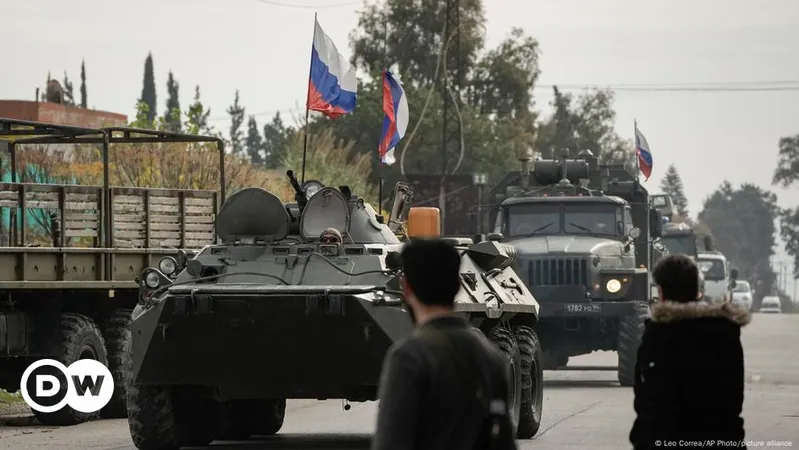
Are Russian Troops Repositioning from Syria to Libya? The Answer Might Shock You!
2024-12-18
Author: Benjamin
Amidst tumultuous changes in the Middle East, analysts are questioning the future of Russian military forces in Syria. Following the recent downfall of Syrian President Bashar Assad’s regime, open-source investigations have revealed unexpected movements at Russian military bases in Syria, raising concerns about the Kremlin's next strategic steps.
Reports from satellite imagery and air traffic tracking indicate significant activity at key Russian sites, including the Tartus naval base and Hmeimim air base. Investigators have noted the dismantling of attack helicopters and the relocation of an S-400 air defense system, alongside sightings of Russian personnel with luggage ready to depart. Notably, Russian naval vessels left Syrian waters on December 11, shortly before Assad's regime crumbled.
Despite these observations, Russian officials staunchly deny any plans for withdrawal, asserting that negotiations with the newly rising rebel power, Hay'at Tahrir al-Sham (HTS), are ongoing. HTS has assumed control of Syria's transitional government post-Assad. Russia has historically had a complex relationship with HTS, having previously engaged in military actions against them while now appearing to rely on their protection for Russian convoys.
The geopolitical landscape in Syria has shifted dramatically, raising questions about Russia’s long-term military presence. Currently, the Russian navy is seen transferring advanced military assets from Syria to Libya, as indicated by reports from the Wall Street Journal citing US and Libyan officials. This leaves experts speculating about Russia's intentions: are they solidifying their presence in Libya as part of a broader strategy in North Africa?
Several key indicators point to a possible pivot to Libya. The removal of military equipment from Syria, along with the suspension of vital wheat exports to the country—where Russia has been a primary supplier—suggests a diminishing focus on Syria. The future of Russia’s naval operations could hinge on whether their vessels choose to dock at strategic Libyan ports, particularly Tobruk.
Political analysts caution that while speculation abounds, the reality of Russia's military operations has fundamentally changed. Political scientist Jalel Harchaoui notes that the comfort and security that Russian troops once enjoyed have dissipated, potentially complicating their logistical capabilities in the region.
The importance of Libya is escalating as Russian military infrastructure is reportedly being fortified. Sources reveal that in 2024, Russian forces have been bolstering air bases in Libya, constructing new facilities, and enhancing defenses—a clear indication of a growing military foothold.
Libya remains a fractured nation, divided between rival governments in the east and west. The eastern faction, supported by Khalifa Haftar, maintains a tenuous grip on power. With Russia’s influence looming, the future political equilibrium in Libya is uncertain. Experts warn that the shift in Syrian power dynamics could have far-reaching implications for Libya, potentially reigniting conflict in a region that has remained delicately balanced thanks to foreign military presences, particularly those of Russia and Turkey.
Should Russia cement its operations in Libya, it would pose a formidable challenge to NATO's strategies in the region. The establishment of a permanent Russian naval base in Libya has long been a goal for Moscow, and US officials have been keen to prevent this from materializing.
In conclusion, while the future of Russian military operations in Syria remains murky, the inclinations towards Libya are clear. Whether through continued engagement in Syria or a potential base in Libya, the outcomes of these developments could reshape the balance of power in North Africa and send shockwaves through the international political landscape. Keep an eye out—this story is far from over!









 Brasil (PT)
Brasil (PT)
 Canada (EN)
Canada (EN)
 Chile (ES)
Chile (ES)
 España (ES)
España (ES)
 France (FR)
France (FR)
 Hong Kong (EN)
Hong Kong (EN)
 Italia (IT)
Italia (IT)
 日本 (JA)
日本 (JA)
 Magyarország (HU)
Magyarország (HU)
 Norge (NO)
Norge (NO)
 Polska (PL)
Polska (PL)
 Schweiz (DE)
Schweiz (DE)
 Singapore (EN)
Singapore (EN)
 Sverige (SV)
Sverige (SV)
 Suomi (FI)
Suomi (FI)
 Türkiye (TR)
Türkiye (TR)